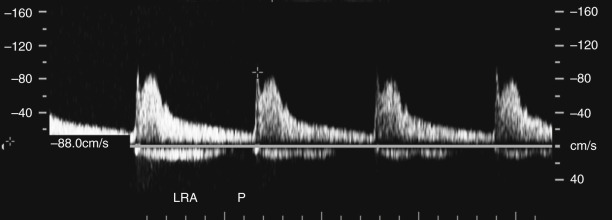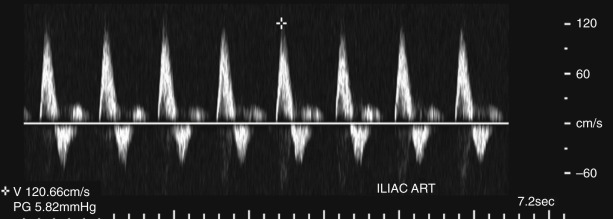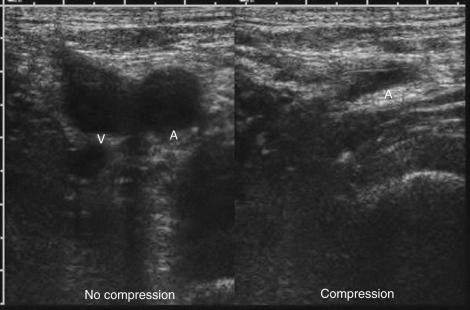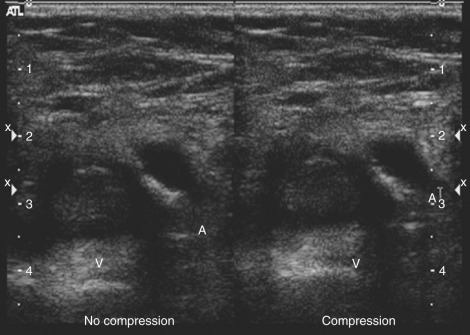Physical Address
304 North Cardinal St.
Dorchester Center, MA 02124
Vascular ultrasound is commonly used to evaluate the following:
Extremity deep venous thrombosis.
Carotid artery stenosis.
Abdominal aortic aneurysm.
Renal artery stenosis.
Hepatic vasculature in the setting of cirrhosis and after transjugular intrahepatic portosystemic shunt (TIPS) placement.
Pseudoaneurysm and arteriovenous fistula.
Flow within vessels is detected and displayed with the use of color and spectral Doppler imaging. Color Doppler US with pulsed spectral display allows for the presence or absence of flow to be displayed (as a color) as well as the direction, velocity, and character of the blood flow. The Doppler spectral display is the waveform in a vessel that depicts both the speed and direction of blood flow (i.e., velocity). By convention, the waveform for blood flowing toward the transducer is depicted above the zero velocity baseline, and the color in the vessel is displayed as red. In contrast, the waveform for blood flowing away from the transducer is displayed below the baseline, and the color in the vessel is displayed as blue.
A spectral Doppler waveform of a vessel contains both quantitative and qualitative information regarding blood flow in the interrogated vessel. Quantitative measurements include absolute velocities (peak systolic velocity (PSV), end diastolic velocity [EDV]), velocity ratios, and acceleration times. Qualitative measurements include the shape of the waveform and spectral broadening (a sign of turbulent flow; when normal blood flow is disturbed, blood has a wider range of velocities).
Velocity measurements in a vessel help to detect stenosis. As a vessel narrows, the velocity in the vessel increases at the point of stenosis in order to maintain the same rate of blood flow through the stenosed region. The degree of vessel stenosis correlates best with the PSV measurement when the stenosis is >50%, such that the greater the degree of stenosis the higher the PSV in the waveform. Another measure of stenosis or resistance in a vascular bed is the resistive index (RI): RI = (S-D)/S, where S is the PSV of blood flow in a vessel and D is the EDV. PSV and EDV can both be used to evaluate blood flow in a vessel when the direction of flow can be clearly identified (i.e., in the carotid artery), whereas RI is more commonly used when the direction of flow cannot be identified (e.g., with renal transplant vascularity). Table 64-1 outlines the characteristic changes of an arterial waveform in relation to a stenosis.
| LOCATION | PSV | DIASTOLIC FLOW | OTHER |
|---|---|---|---|
| Proximal to stenosis | Decreased | Decreased | |
| At stenosis | Increased | Increased | Turbulence with spectral broadening |
| Distal to stenosis | Decreased | Decreased | Decreased acceleration time; tardus parvus |
Flow within arteries supplying organs that require constant perfusion include arteries to the brain, liver, and kidneys. The waveforms in these arteries will have continuous monophasic forward flow toward the organ throughout diastole. They have broad systolic peaks, gradual transition between systole and diastole, and persistent diastolic flow ( Figure 64-1 ). Low-resistance vessels will also have low RIs.

Flow within arteries supplying structures with variable flow demands, such as the extremities at rest and the bowel during fasting, have higher resistance triphasic waveforms. These waveforms are characterized by narrow systolic peaks, followed by an abrupt transition between systole and diastole with transient reversal of diastolic flow, and then a return of low-level forward flow during the rest of diastole ( Figure 64-2 ).

Veins typically have low-level monophasic waveforms. There can be some pulsatility of the waveform in veins closer to the heart, such as the hepatic veins. A normal vein in the extremity will also have some respiratory and cardiac waveform variability.
US is the initial imaging study of choice for evaluating suspected upper or lower extremity deep vein thrombosis (DVT). In symptomatic patients, the sensitivity and specificity of US for DVT is at least 95% and 98%, respectively. The most important sonographic feature used to diagnose DVT is venous compressibility. Normally, the deep extremity veins are fully compressible ( Figure 64-3 ). In contrast, thrombosed veins will not fully compress ( Figure 64-4 ). The gray scale luminal echogenicity of the vein is less reliable, because normal veins can have artifactual low-level echoes and intraluminal clot can be hypoechoic or anechoic. Color Doppler US depicts venous thrombus as a filling defect or absence of flow.


Additional color Doppler features that can be assessed include spontaneous and phasic venous flow in response to augmentation. A venous waveform that lacks normal respiratory phasicity can indicate venous obstruction superior to that site. Similarly, compression of veins inferior to the vein being examined normally increases flow on spectral display. Lack of increased flow with augmentation indicates venous obstruction somewhere in between the site of compression and the Doppler site.
Become a Clinical Tree membership for Full access and enjoy Unlimited articles
If you are a member. Log in here